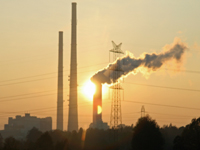Clean Coal - The Devil Lies in the Details

GLOBE-Net - There was a lot of talk about “Clean coal technology” during the election campaign in the United States. Both the Democratic and Republican nominees wanted to place it at the forefront of their energy independence strategy. John McCain pledged to speed up its development with a $2 billion a year investment until 2024. Barack Obama wanted to build “five ’first-of-a-kind’ commercial scale coal-fired plants with carbon capture and sequestration.”
Essentially, McCain and Obama want power station smokestacks to grab the carbon dioxide (CO2) they emit when they burn coal. The CO2 would be transported to a storage site via pipelines, ships, rail or trucks. There it would be injected into rock formations deep below the Earth’s surface. Since the U.S. is the world’s second largest emitter of CO2 emissions after China, the technology would reduce air pollution substantially.
Yet both candidates slid over the details that make their proposals more complicated than meets the eye. First, there is question of cost. The technology exists to capture and store CO2 - the oil industry has been doing it for years – but it has never been applied in a large-scale commercial project.
“There’s no such thing as clean coal. It’s non-existent.”
Former U.S. Vice-President Al Gore
In 2003 President George W. Bush hailed a public-private partnership to build a near-zero emission coal plant - FutureGen – by 2012. But the plant never left the development stage and astronomical cost overruns convinced the federal government to pull the plug in January 2008.
Second, the pumping of carbon gas into the ground has cause for concern for both the industry and environmentalists. What worries plant owners is the risk that lawyers pose to their investment. “Without clear rules and guidelines on the question of liability at the state and federal level, the industry would probably be reluctant to deploy this technology,” says Michael Catanzaro of energy firm PPL Corp. during an interview with the Wall Street Journal.
Environmentalists wonder if the underground deposits of carbon dioxide will stay leak proof. The gas could migrate sideways into groundwater or upwards to the surface. “Undetected fractures in cap rocks or those created by injecting CO2 at too high a pressure can provide another avenue for CO2 to escape. Improper design and construction of wells can also create opportunities for leakage,” explains a Greenpeace report on carbon capture.
There is also a concern that the technology will not get to the market until too late. The industry’s own predictions do not foresee carbon capture and storage becoming viable before 2020 at the earliest. But to avoid the worst excesses of climate change, global greenhouse gas emissions must peak by 2015 and start falling to at least 50 percent by 2050.
Finally, there needs to be a huge processing and transportation infrastructure in place to make a meaningful dent in climate change. According to the Union of Concerned Scientists, the infrastructure would have to handle a volume of liquefied carbon dioxide rivaling that of the oil consumed by the United States. The annual storage space needed for the emissions of a typical 600-megawatt plant would be about four times the volume of the Empire State Building.
“Even if carbon capture and storage works on a commercial scale, coal will still be dirty,” says Steve Clemmer UCS Clean Energy Program research director and co-author of the report Coal Power in a Warming World. “The technology doesn’t address the environmental threat posed by mining, transporting and disposing of coal.”
The Union of Concerned Scientists thinks the U.S. federal government should first fund five to 10 full-scale demonstration projects. These would allow experts to determine if carbon dioxide can be stored indefinitely and in what type of underground geological formations.
One solution may come from India and China. These two countries, according to the The Wall Street Journal, have been at the forefront of new research into underground coal gasification. This technology, pioneered by the Soviet Union during the 1930s, involves drilling a borehole into a coal seam which is then ignited. The gases produced by the combustion are forced to the surface through a second borehole where they are harnessed to feed turbines. The Wall Street Journal says 30 such projects - at various stages of preparation – currently exist in China.
Regardless, coal will remain an essential part of the world economy for years to come. The International Energy Agency predicts that there will be a 73 percent increase in global demand for coal by 2030. Clean coal technology might provide a solution to climate change, but even with massive governmental support, it is not likely to make a significant difference in the near future.
For More Information: Greenpeace InternationalYou can return to the main Market News page, or press the Back button on your browser.


